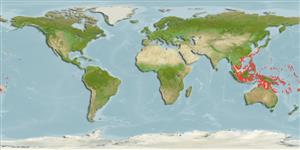Common names from other countries
>
Eupercaria/misc (Various families in series Eupercaria) >
Lutjanidae (Snappers) > Lutjaninae
Etymology: Lutjanus: Malay, ikan lutjan, name of a fish.
More on author: Lacepède.
Environment: milieu / climate zone / depth range / distribution range
Ecologia
marinhas associadas(os) a recifes; intervalo de profundidade 3 - 50 m (Ref. 9710). Tropical; 35°N - 21°S, 93°E - 170°W
Western Pacific: Sumatra to Samoa, north to southern Japan. Apparently restricted to the western Pacific (Ref. 30829).
Tamanho / Peso / Idade
Maturity: Lm ? range ? - ? cm
Max length : 35.0 cm TL macho/indeterminado; (Ref. 48635); common length : 20.0 cm TL macho/indeterminado; (Ref. 55)
Espinhos dorsais (total): 10 - 11; Raios dorsais (total): 13-14; Espinhos anais 3; Raios anais : 8. Snout somewhat pointed. Eye large. Preorbital bone narrow, its width much less than eye diameter. Preopercular notch and knob well developed. Scale rows on back rising obliquely above lateral line. Generally pink or reddish, white or silvery below. Usually a series of ten to twelve stripes is on the side. Some specimens have black spot on the back below the anterior part of the soft dorsal fin.
Adults inhabit coral reefs. Often seen in schools near outcrops or drop-offs, often with other species (Ref. 9710), of up to about 30 to 40 individuals. Small juveniles on shallow algae reef, often near freshwater run-offs (Ref. 48635). Feed on fishes, shrimps, crabs, other crustaceans, cephalopods and some planktonic items.
Ciclo de vida ou comportamento de acasalamento
Maturidade | Reprodução | Desova | Ovos | Fecundidade | Larvas
Allen, G.R., 1985. FAO Species Catalogue. Vol. 6. Snappers of the world. An annotated and illustrated catalogue of lutjanid species known to date. FAO Fish. Synop. 125(6):208 p. Rome: FAO. (Ref. 55)
Status na Lista Vermelha da UICN (Ref. 130435)
CITES (Ref. 128078)
Not Evaluated
Ameaça para os humanos
Harmless
Uso pelos humanos
Pescarias: pouco comercial
Mais informação
ReferênciasAquaculturaPerfil para aquaculturaEstirpesGenéticaElectrophoresesHereditariedadeDoençasProcessamentoConversão de massa
ColaboradoresFotosStamps, Coins Misc.SonsCiguateraVelocidadeTipo de nataçãoÁrea branquialOtólitosCérebrosVisão
Ferramentas
Relatórios especiais
Baixar XML
Fontes da internet
Estimates based on models
Preferred temperature (Ref.
115969): 24.3 - 29, mean 28.2 (based on 542 cells).
Índice de diversidade filogenética (Ref.
82804): PD
50 = 0.5000 [Uniqueness, from 0.5 = low to 2.0 = high].
Bayesian length-weight: a=0.01479 (0.00706 - 0.03101), b=2.97 (2.81 - 3.13), in cm Total Length, based on LWR estimates for this Genus-body shape (Ref.
93245).
Nível Trófico (Ref.
69278): 3.8 ±0.56 se; based on food items.
Resiliência (Ref.
120179): Elevada, tempo mínimo de duplicação da população menor que 15 meses (Preliminary K or Fecundity.).
Fishing Vulnerability (Ref.
59153): Low vulnerability (25 of 100).
